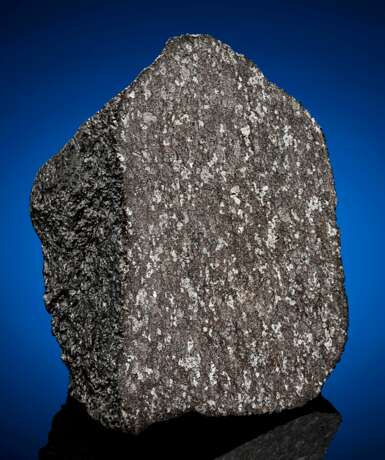ID 389976
Lot 33 | MICROSCOPIC DIAMONDS FROM OUTER SPACE IN UREILITE END PIECE — JIDDAT AL HARASIS (JAH) 809
Estimate value
$ 1 000 – 2 000
This slightly elongated meteorite end piece rises to a gabled peak. The cut and polished face reveals the dark grains of olivine and pigeonite as the primary constituents of the matrix. The outer surface of the meteorite is gently textured. The extraterrestrial diamonds set in the matrix are too small to be seen. For meteorite cognoscenti; modern cutting and polishing.
65 x 43 x 44mm (2.5 x 1.66 x 1.75 in.)
197.5g (0.4 lb)
Three related stone meteorites were found in the Jiddat al Harasis desert region of Oman; now offered is an endpiece of one of the specimens. JaH 809 is classified as a ureilite — a rare type of meteorite (less than 1% of all meteorites are ureilites) whose mineralogical composition is unlike that of other meteorites. Ureilites are primarily comprised of olivine and pigeonite grains as well as carbon in the form of graphite and nanodiamonds. There is currently no known parent body from which ureilites are believed to have originated. Moreover, scientists are not in agreement as to how ureilites form. Ureilites are named after the Russian village Novy Urey where a meteorite of this type fell on September 4, 1886. Many ureilites have a cumulate texture (as does the present specimen); they are igneous rocks that formed from the accumulation of crystals precipitating out of magma (a mixture of molten rock and mineral grains). As a result of the presence of diamonds, ureilite meteorites are typically notoriously difficult to cut.
Christie's would like to thank Dr. Alan E. Rubin at the Institute of Geophysics and Planetary Physics, University of California, Los Angeles for his assistance in preparing this catalogue.
| Address of auction |
CHRISTIE'S 8 King Street, St. James's SW1Y 6QT London United Kingdom | |
|---|---|---|
| Preview |
| |
| Phone | +44 (0)20 7839 9060 | |
| Buyer Premium | see on Website | |
| Conditions of purchase | Conditions of purchase |



